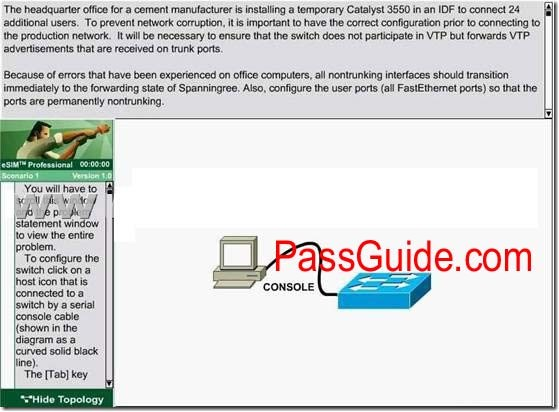LAB
Spanning-Tree Protocol is a link management protocol that provides path redundancy while preventing undesirable loops in the network. For an Ethernet network to function properly, only one active path can exist between two stations. Multiple active paths between stations cause loops in the network. If a loop exists in the network topology, the potential exists for duplication of messages. When loops occur, some switches see stations appear on both sides of the switch. This condition confuses the forwarding algorithm and allows duplicate frames to be forwarded. To provide path redundancy, Spanning-Tree Protocol defines a tree that spans all switches in an extended network. Spanning-Tree Protocol forces certain redundant data paths into a standby (blocked) state. If one network segment in the Spanning-Tree Protocol becomes unreachable, or if Spanning-Tree Protocol costs change, the spanning-tree algorithm reconfigures the spanning-tree topology and reestablishes the link by activating the standby path. Spanning-Tree Protocol operation is transparent to end stations, which are unaware whether they are connected to a single LAN segment or a switched LAN of multiple segments.There is a lab about STP in Cisco CCNP 642-812 / 642-892 exam.
Requirements:
You will configure FastEthernet ports 0/12 through 0/24 for users who belong to VLAN 20. Also, all VLAN and VTP configurations are to be completed in global configuration mode as VLAN database mode is being deprecated by Cisco. You are required to accomplish the following tasks:
1. Ensure the switch does not participate in VTP but forwards VTP advertisements received on trunk ports.
2. Ensure all non-trunking interfaces (Fa0/1 to Fa0/24) transition immediately to the forwarding state of Spanning-Tree.
3. Ensure all FastEthernet interfaces are in a permanent non-trunking mode.
4. Place FastEthernet interfaces 0/12 through 0/24 in VLAN 20

Answer:
Solutions:
*But dont enter ‘vtp mode transparent’ command at begining of configuration. if you do that you will not be able to add vlan 10 to the switch. vlan 10 is not existing in the switch and it needs to be created, it will create automatically if you follow the pass4sure answer. In transparent mode vlan creation is not possible. So, do every configuration and the last moment change the vtp mode to transparent.
Switch#conf t
Switch(config)#interface range fa0/1 – 24
Switch(config-if-range)#switchport mode access (Brings the interfaces into access mode) Switch(config-if-range)#spanning-tree portfast (Enables the PortFast on interface.)
_The fastEthernet interfaces 0/12 through 0/24 should be placed in VLAN 20
Switch(config)#interface range fa0/12 – 24
Switch(config-if-range)#switchport access vlan 20 (Makes the members of vlan 20) Switch(config-if-range)#exit
Switch(config)#vtp mode transparent
Switch(config)#exit
Switch#copy run start
Spanning tree PortFast is a Catalyst feature that causes a switch or trunk port to enter the spanning tree Forwarding state immediately, bypassing the Listening and Learning states. IOS-based switches only use PortFast on access ports connected to end stations. When a device is connected to a port, the port normally enters the spanning tree Listening state. When the Forward Delay timer expires, the port enters the Learning state. When the Forward Delay timer expires a second time, the port is transitioned to the Forwarding or Blocking state. When PortFast is enabled on a switch or trunk port, the port is immediately transitioned to the Forwarding state. As soon as the switch detects the link, the port is transitioned to the Forwarding state (less than 2 seconds after the cable is plugged in).


